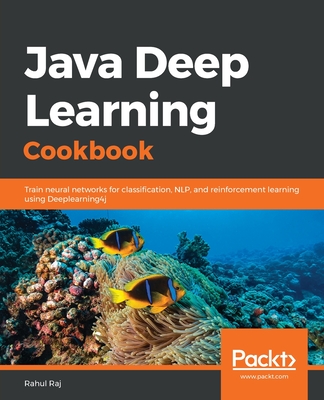Deep Learning Quick Reference: Over 10 secret hacks for training and optimizing deep neural networks with TensorFlow and Keras
暫譯: 深度學習快速參考:超過10個訓練和優化深度神經網絡的秘密技巧,使用TensorFlow和Keras
Mike Bernico
- 出版商: Packt Publishing
- 出版日期: 2018-03-13
- 售價: $1,650
- 貴賓價: 9.5 折 $1,568
- 語言: 英文
- 頁數: 272
- 裝訂: Paperback
- ISBN: 1788837991
- ISBN-13: 9781788837996
-
相關分類:
DeepLearning
海外代購書籍(需單獨結帳)
買這商品的人也買了...
-
 $1,088Deep Learning with TensorFlow - Second Edition: Explore neural networks with Python
$1,088Deep Learning with TensorFlow - Second Edition: Explore neural networks with Python -
 $1,332Hands-On Reinforcement Learning with Python: Master reinforcement and deep reinforcement learning using OpenAI Gym and TensorFlow
$1,332Hands-On Reinforcement Learning with Python: Master reinforcement and deep reinforcement learning using OpenAI Gym and TensorFlow -
 $1,080PyTorch Deep Learning Hands-On: Apply modern AI techniques with CNNs, RNNs, GANs, reinforcement learning, and more
$1,080PyTorch Deep Learning Hands-On: Apply modern AI techniques with CNNs, RNNs, GANs, reinforcement learning, and more
相關主題
商品描述
Dive deeper into neural networks and get your models trained, optimized with this quick reference guide
Key Features
- A quick reference to all important deep learning concepts and their implementations
- Essential tips, tricks, and hacks to train a variety of deep learning models such as CNNs, RNNs, LSTMs, and more
- Supplemented with essential mathematics and theory, every chapter provides best practices and safe choices for training and fine-tuning your models in Keras and Tensorflow.
Book Description
Deep learning has become an essential necessity to enter the world of artificial intelligence. With this book deep learning techniques will become more accessible, practical, and relevant to practicing data scientists. It moves deep learning from academia to the real world through practical examples.
You will learn how Tensor Board is used to monitor the training of deep neural networks and solve binary classification problems using deep learning. Readers will then learn to optimize hyperparameters in their deep learning models. The book then takes the readers through the practical implementation of training CNN's, RNN's, and LSTM's with word embeddings and seq2seq models from scratch. Later the book explores advanced topics such as Deep Q Network to solve an autonomous agent problem and how to use two adversarial networks to generate artificial images that appear real. For implementation purposes, we look at popular Python-based deep learning frameworks such as Keras and Tensorflow, Each chapter provides best practices and safe choices to help readers make the right decision while training deep neural networks.
By the end of this book, you will be able to solve real-world problems quickly with deep neural networks.
What you will learn
- Solve regression and classification challenges with TensorFlow and Keras
- Learn to use Tensor Board for monitoring neural networks and its training
- Optimize hyperparameters and safe choices/best practices
- Build CNN's, RNN's, and LSTM's and using word embedding from scratch
- Build and train seq2seq models for machine translation and chat applications.
- Understanding Deep Q networks and how to use one to solve an autonomous agent problem.
- Explore Deep Q Network and address autonomous agent challenges.
Who This Book Is For
If you are a Data Scientist or a Machine Learning expert, then this book is a very useful read in training your advanced machine learning and deep learning models. You can also refer this book if you are stuck in-between the neural network modeling and need immediate assistance in getting accomplishing the task smoothly. Some prior knowledge of Python and tight hold on the basics of machine learning is required.
Table of Contents
- The Building Blocks of Deep Learning
- Using Deep Learning To Solve Regression Problems
- Monitoring Network Training Using Tensor Board
- Using Deep Learning To Solve Binary Classification Problems
- Using Keras To Solve MultiClass Classification Problems
- HyperParameter Optimization
- Training a CNN From Scratch
- Transfer Learning with Pretrained CNNs
- Training an RNN from scratch
- Training LSTMs with Word Embeddings From Scratch
- Training Seq2Seq Models
- Using Deep Reinforcement Learning
- Deep Convolutional Generative Adversarial Networks
商品描述(中文翻譯)
深入了解神經網絡,並使用這本快速參考指南訓練和優化您的模型
主要特點
- 所有重要深度學習概念及其實現的快速參考
- 訓練各種深度學習模型(如 CNN、RNN、LSTM 等)的基本技巧、竅門和方法
- 每章節補充必要的數學和理論,提供最佳實踐和安全選擇,以便在 Keras 和 TensorFlow 中訓練和微調您的模型。
書籍描述
深度學習已成為進入人工智慧世界的必要條件。這本書使深度學習技術變得更易於接觸、實用且與實踐中的數據科學家相關。它通過實際範例將深度學習從學術界帶入現實世界。
您將學習如何使用 Tensor Board 監控深度神經網絡的訓練,並使用深度學習解決二元分類問題。讀者接著將學習如何優化其深度學習模型中的超參數。然後,這本書將引導讀者從零開始實際實現訓練 CNN、RNN 和 LSTM,並使用詞嵌入和 seq2seq 模型。隨後,書中探討了高級主題,如深度 Q 網絡以解決自主代理問題,以及如何使用兩個對抗網絡生成看似真實的人工圖像。為了實現目的,我們將關注流行的基於 Python 的深度學習框架,如 Keras 和 TensorFlow。每章提供最佳實踐和安全選擇,以幫助讀者在訓練深度神經網絡時做出正確的決策。
在本書結束時,您將能夠快速使用深度神經網絡解決現實世界的問題。
您將學到什麼
- 使用 TensorFlow 和 Keras 解決回歸和分類挑戰
- 學習使用 Tensor Board 監控神經網絡及其訓練
- 優化超參數和安全選擇/最佳實踐
- 從零開始構建 CNN、RNN 和 LSTM,並使用詞嵌入
- 構建和訓練 seq2seq 模型以進行機器翻譯和聊天應用。
- 理解深度 Q 網絡及如何使用其解決自主代理問題。
- 探索深度 Q 網絡並解決自主代理挑戰。
本書適合誰
如果您是數據科學家或機器學習專家,那麼這本書對於訓練您的高級機器學習和深度學習模型非常有用。如果您在神經網絡建模中遇到困難,並需要立即協助以順利完成任務,您也可以參考這本書。需要具備一些 Python 的先前知識以及對機器學習基礎的扎實掌握。
目錄
- 深度學習的基礎構件
- 使用深度學習解決回歸問題
- 使用 Tensor Board 監控網絡訓練
- 使用深度學習解決二元分類問題
- 使用 Keras 解決多類別分類問題
- 超參數優化
- 從零開始訓練 CNN
- 使用預訓練 CNN 的遷移學習
- 從零開始訓練 RNN
- 從零開始訓練 LSTM 與詞嵌入
- 訓練 Seq2Seq 模型
- 使用深度強化學習
- 深度卷積生成對抗網絡














